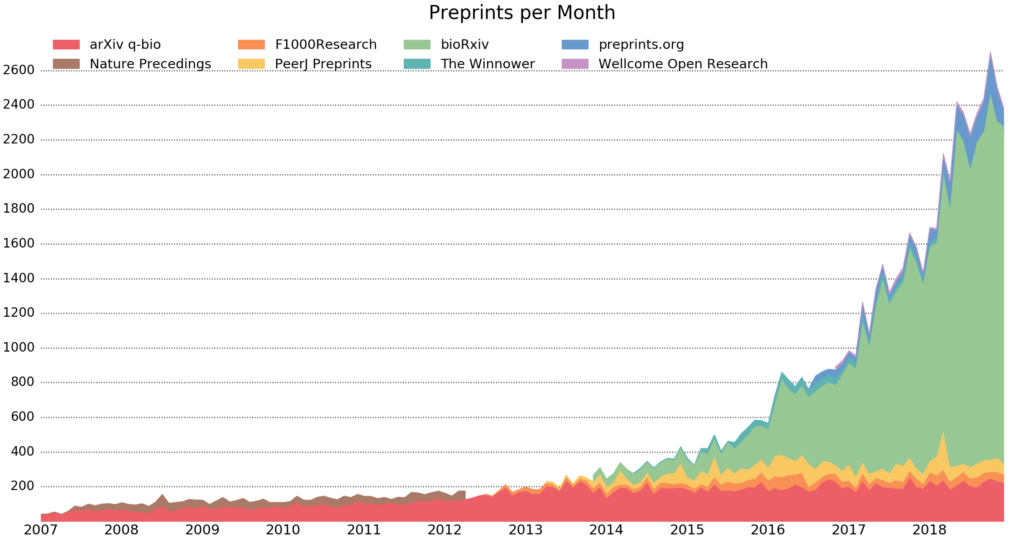If you have decided to publish a preprint (congrats!), you may be wondering how to go about it. Here’s all you need to know about getting your manuscript preprint-ready. This is the third and last part of my blog series on preprints.
Even though preprints aren’t a good fit for all papers, there are so many benefits to publishing a preprint, it’s often worthwhile – especially for early career researchers and new PI’s.
And preprints are becoming more and more common. While the preprint server arXiv has been very popular for more than a decade, the younger platform bioRxiv is mainly responsible for a recent growth in preprint submission:

Are you planning to submit a preprint for the first time? You may be wondering what you need to know about writing and submitting a preprint. Here are my five top tips for preparing a preprint:
1. Take the same care as for a journal manuscript
A preprint may not come with the same prestige as an article in a peer-reviewed journal. Nevertheless, I strongly advise you to put the same care into writing your manuscript. Your preprint will be openly accessible, cannot be removed from the server and will likely receive higher exposure than your journal article. Every preprint also receives a DOI and is citable. That’s why you want to leave the right impression and make sure your findings and ideas are understood.
As for any paper, make sure that all sections are in shape and a storytelling structure is in place. Also, I recommend avoiding any of these common scientific writing mistakes if you want your preprint to work in your favour.
The preprints are screened for plagiarism and non-scientific or offensive content before being published on the server. However, they are not being edited or typeset, so ensure that the format and language make your preprint an effortless read. If you were going to hire an external editor such as me to advise on structure and language, get them onboard before submitting the preprint.
Once submitted to chemRxiv or bioRxiv, you can still revise your preprint until it is published in a journal while keeping the same DOI. However, you cannot edit your preprint in real time but need to submit a revised version of your article. You can usually do this as many times as you wish, but the preprint server may reserve the right to decline a new version. Also, journals may have rules prohibiting preprint revisions while the manuscript is under review, so please check.
2. Don’t leave out data or detailed method descriptions
I understand, you really don’t want to get scooped. While this is a common concern, getting your idea scooped from a preprint is not very likely (see concern #4 in part 1 of this preprint series).
Leaving out important data or keeping methods description very general is just not fair. Publishing a preprint can have a lot of benefits for you by giving you priority, more visibility, higher citations and the chance to improve it before publishing in a journal. Make it worthwhile for your peers as well and give them the full story and a chance to reproduce your results. As described in tip #1, just treat your preprint as any high-quality paper.
3. Choose the right copyright license for you
When uploading your preprint to a server such as bioRxiv or chemRxiv, you keep the copyright to the work. And you can decide to what extent you allow the work to be reused. Different preprint servers allow you to choose from different licences. ChemRxiv, for example, offers three: CC-BY 4.0 (a Creative Commons licence permitting any reuse with attribution), CC-BY-NC 4.0 (a Creative Commons licence permitting reuse only for non-commercial purposes) and CC-BY-NC-ND 4.0 (as the previous licence but additionally bars users from modifying the work in any way, such as by adding annotations, translating or reformatting). If you would like to read more about your legal rights as an author, please check out this collection of FAQ’s by ASAPbio, a website that also features other valuable information on preprints.

4. Check your target journal policies
Even though most publications allow preprinting, it’s worth checking what the journal policies state. You can start with these collections on Wikipedia and SHERPA RoMEO. If you find that your publisher’s take on preprints in these lists is ambiguous, I recommend diving into the details of their journal policies. For this, the Transpose database may come in handy, which has gathered the policies of several thousand journals (Thank you, pranea, for suggesting this). If you’re still unsure, you can also contact the publisher’s office to get an answer.
5. Share and promote your preprint and welcome comments
One major benefit of preprints is that you can receive feedback on your work from peers. Therefore, your job shouldn’t be finished by just uploading the preprint. I encourage you to share it and promote it.
You could, for example, send the link to your collaborators and colleagues and express that you welcome criticism and suggestions. If you have any particular parts that you would like to receive feedback on, such as a specific measurement, the interpretation of a certain data series or whether your writing is clear, do ask your peers for feedback on this specifically. Otherwise it’s easy to have someone point out a missing comma while you were looking for opinions on the line of argument.
Apart from sharing your preprint with peers known to you, you can hop on social media and share it. I frequently see authors post their preprints on Twitter asking for feedback, arguably the platform where most academics like to talk about science. Naturally, the larger your following, the more visible your tweet will be. But even if you only have a small number of followers, you can still use hashtags (such as #AcWri #preprint #AcademicTwitter, or field-specific ones such as #ChemTwitter) and tag relevant scientists or labs.
ChemRxiv or bioRxiv also tweet about just accepted preprints. It may be worth knowing that ChemRxiv includes an image in the tweet. They told me that their first choice for this image is the table of contents (TOC) or summary figure of the paper, if the author has identified one. Therefore, it is a good idea to include one in your preprint submission (PS: Here are some essential tips for creating a graphical abstract that can be used as a TOC or summary figure).
Asking for feedback on your preprint also means leaving some time between the preprint and journal submission. So, plan accordingly!
There you have it: Five tips for preparing for a preprint submission. Has this guide been useful to you? Would you add anything? Let me know in a comment below!


